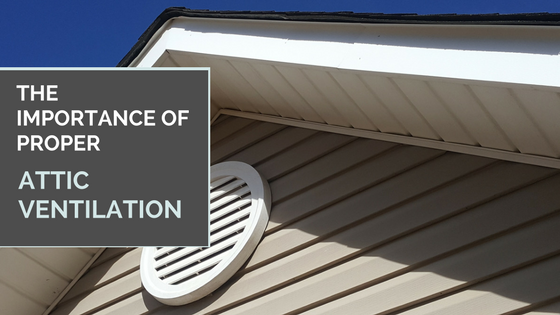The Importance of Proper Attic Ventilation

Something most people don’t realize is that the attic of your home is actually a crucial element in your home’s structure especially surrounding attic ventilation. Proper ventilation and insulation can be the different between replacing your roof today or 10 years down the road. We’ll outline the details of how attic ventilation works and why it’s such a crucial element for your home.
What is Attic Ventilation?
Attic ventilation is a series of vents in your roofing system that increases the airflow within your home’s attic. Newer homes generally have the appropriate number of attic vents to suit the size of the home and the size of the roof, but older homes may need added vents or use attic fans as a means of ventilation.
Why do you need Attic Ventilation?
Attic ventilation is most important in the winter time as it prevents ice dams from forming on your roof. If your attic is not properly ventilated, heat that is trapped in your attic over the winter can cause snow on your roof to melt. As the melted snow starts falling off the roof, it will freeze near your gutters where there is no heat. These ice dams grow larger and larger with each snow fall building up on the gutters and sides of your roof, leading to serious water damage that can be expensive to repair.
Proper attic ventilation is also important over the warm summer months as well. In the summer, heat absorbed by your roof can become trapped in the attic. Without ventilation, the humidity can cause mould and rot that will damage the structure of your roof. Proper ventilation allows that hot air to escape while keeping your home safe.
The 1:300 Rule
As a general rule, your roof should have 1 square foot of ventilation for every 300 square feet of ceiling. The type of ventilation that is best for your home is something best discussed with a qualified roofing contractor that can provide expertise on what will benefit your home the most. The type of ventilation widely depends on your home, the style of your roof and how much heat your roof will absorb.
How do you know if your attic is properly ventilated?
If you begin to see ice dams forming on your roof or evidence of water damage, mould or rot in your attic, chances are you don’t have enough ventilation. It’s also important to check your insulation. A poorly insulated attic can lead to a lot of the same issues and it’s often easier to add more insulation than it is to add additional ventilation to your attic.
When you have proper roof ventilation and attic insulation, ice dams and roof rot won’t be a problem. If you suspect an issue with your attic ventilation, give the experts at In Awe Roofing a call. We’ll come out and conduct a free assessment on your attic ventilation as well as your roof and make recommendations based on our findings.

In Awe Roofing Limited is an Award-Winning, family owned and operated Vancouver Roofing Contractor with over 17 years of roofing experience. We serve the entire Lower Mainland area, from Whistler to Chilliwack, employing a team of professional staff members. Our team has won numerous awards including Best of Homestars for the last five years, and Three Best Rated six years in a row. Learn more






















